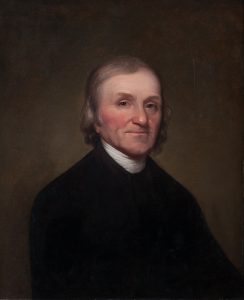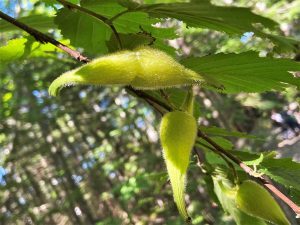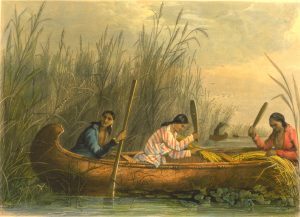On February 28, 1798, an article in the Greenfield Gazette detailed plans for an exciting new museum. A veritable “cabinet of curiosities,” the institution would be housed at Deerfield Academy, in Deerfield, Massachusetts. Today, the organization is one of the oldest preparatory schools in the United States. Their eclectic collection included donations from Dartmouth College, Boston area museums, and “many curious articles from many private gentlemen and ladies.”

The late 18th century was a pivotal time in the development of scientific understanding. The “tree of knowledge” flourished during the Age of Enlightenment, with new discoveries by curious scientists, including Benjamin Franklin, William Bartram, and Joseph Priestley. Science also became more accessible as everyday citizens attended popular lectures, read printed works, roamed public gardens, and patronized museums.
Joseph Priestly, an influential chemist, wide-ranging educator, natural philosopher, and radical theologian, epitomized this spirit of discovery. Priestly published and lectured often, becoming a close friend and collaborator with Benjamin Franklin. Deerfield Museum founders were influenced by his advice, writing, “Dr. Priestley, in his lectures, shows the importance of such collections, as they respect history; and as the natural history of America is yet very imperfect, gentleman may be of essential service to it, by depositing specimens of minerals the skins of peculiar animals, or whatever may appear to them uncommon…”
Which Mackinac wonders would you pick to display in this “infant museum” of early America? A unique specimen of Mackinac limestone? Animal pelts from the world-renowned fur trade? The delectable whitefish, or a 70-pound Mackinac trout? A closer look at this fascinating assemblage reveals the following curiosities:
- Petrifications [fossils] from different parts of the country
- Stone tools, clay pots, pipes, a bow and a number of arrows
- Crystals and ores
- Several fish hooks and lines
- A spoon and a comb, made by Pacific Island inhabitants, visited by Captain Cook
- The saw of a sawfish
- A tooth of the spermaceti whale and jaw of a mackerel whale
- The jaws of a Shark, with the teeth
- Bills of a toucan and a pelican
- The head and egg of an ostrich
- A puffing fish, a coney, and sea wolf
- A centipede of the West Indies
- A young alligator and the egg of the albatross
- Rare insects and reptiles, including a two-headed snake
- “Nuts from Michilimackinac, called by the natives Pickens – and Indian rice from the same place”

“Nuts from Michilimackinac, called by the natives Pickens,” likely refers to fruits of the hazelnut tree. The word pecan originates from the word pakan, meaning “hard shelled nut” in the Algonquian language family. Spelled with many variations over eastern North America, the word translates as bagaan in Anishinaabemowin, spoken by Ojibwe and Odawa people in the Mackinac region. A member of the birch family, there are 15 species of hazels in North America. Beaked hazelnut (Corylus rostrata) grows in the North Woods at Mackinac. In his 1920 botanical report, Charles K. Dodge noted they were common in “rich open ground from Bay County to St. Ignace and on Mackinac Island.”

Wild Rice is one of the few staple grains native to North America. It belongs to a genus of tall, aquatic grasses of the genus Zizania, which thrived in marshes throughout the upper Great Lakes. Anishinaabek call the plant manoomin. In Ojibwe culture, its importance rises beyond a rich food source, with many related stories, symbols, and ceremonies associated with its use and harvest. While wild rice grew in the eastern Upper Peninsula it was never overly abundant here, often being traded from Green Bay. Draining of marshes and impaired water quality greatly reduced its range in the 20th century.
In 1800, a large birchbark canoe made its way from Lake Huron to Peale’s Museum in Philadelphia. Founded in 1786 by artist Charles Willson Peale, the institution is considered the most important museum of early America. Peale’s expansive collection featured portraits of prominent individuals, natural history specimens, and cultural artifacts from around the world. The canoe was donated by Dr. Charles Brown, U.S. army surgeon at Detroit, who paddled it to New York. Constructed at Saginaw Bay by “an Indian woman,” the lightweight craft measured 23 feet long, 4 feet in breadth and 26 inches deep. Canoes were indispensable for transportation on the Great Lakes, plying rivers and lakes throughout the U.S. and Canada, including the Straits of Mackinac. It was said the donated craft “carried six persons and 1,200 weight of baggage across the Lakes.”
The next time you visit the straits, consider which items might be fit for a museum of the 22nd century. Would your futuristic exhibit feature a slab of petrified fudge? A bicycle with pedals? Or fragrant blossoms of a lilac tree? Whatever change may come over the next century, we can rest assured that Lake Huron waters will lap against the rocky shore, welcoming visitors to Mackinac as they have since time immemorial.









